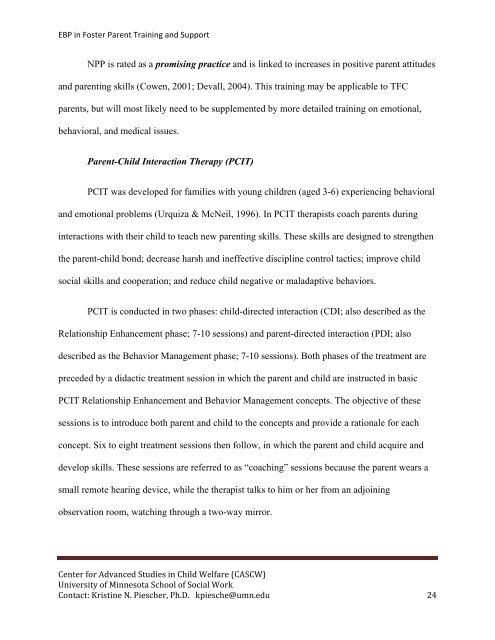Evidence-Based Practice in Foster Parent Training and Support ...
Evidence-Based Practice in Foster Parent Training and Support ...
Evidence-Based Practice in Foster Parent Training and Support ...
You also want an ePaper? Increase the reach of your titles
YUMPU automatically turns print PDFs into web optimized ePapers that Google loves.
EBP <strong>in</strong> <strong>Foster</strong> <strong>Parent</strong> Tra<strong>in</strong><strong>in</strong>g <strong>and</strong> <strong>Support</strong>NPP is rated as a promis<strong>in</strong>g practice <strong>and</strong> is l<strong>in</strong>ked to <strong>in</strong>creases <strong>in</strong> positive parent attitudes<strong>and</strong> parent<strong>in</strong>g skills (Cowen, 2001; Devall, 2004). This tra<strong>in</strong><strong>in</strong>g may be applicable to TFCparents, but will most likely need to be supplemented by more detailed tra<strong>in</strong><strong>in</strong>g on emotional,behavioral, <strong>and</strong> medical issues.<strong>Parent</strong>-Child Interaction Therapy (PCIT)PCIT was developed for families with young children (aged 3-6) experienc<strong>in</strong>g behavioral<strong>and</strong> emotional problems (Urquiza & McNeil, 1996). In PCIT therapists coach parents dur<strong>in</strong>g<strong>in</strong>teractions with their child to teach new parent<strong>in</strong>g skills. These skills are designed to strengthenthe parent-child bond; decrease harsh <strong>and</strong> <strong>in</strong>effective discipl<strong>in</strong>e control tactics; improve childsocial skills <strong>and</strong> cooperation; <strong>and</strong> reduce child negative or maladaptive behaviors.PCIT is conducted <strong>in</strong> two phases: child-directed <strong>in</strong>teraction (CDI; also described as theRelationship Enhancement phase; 7-10 sessions) <strong>and</strong> parent-directed <strong>in</strong>teraction (PDI; alsodescribed as the Behavior Management phase; 7-10 sessions). Both phases of the treatment arepreceded by a didactic treatment session <strong>in</strong> which the parent <strong>and</strong> child are <strong>in</strong>structed <strong>in</strong> basicPCIT Relationship Enhancement <strong>and</strong> Behavior Management concepts. The objective of thesesessions is to <strong>in</strong>troduce both parent <strong>and</strong> child to the concepts <strong>and</strong> provide a rationale for eachconcept. Six to eight treatment sessions then follow, <strong>in</strong> which the parent <strong>and</strong> child acquire <strong>and</strong>develop skills. These sessions are referred to as “coach<strong>in</strong>g” sessions because the parent wears asmall remote hear<strong>in</strong>g device, while the therapist talks to him or her from an adjo<strong>in</strong><strong>in</strong>gobservation room, watch<strong>in</strong>g through a two-way mirror.Center for Advanced Studies <strong>in</strong> Child Welfare (CASCW)University of M<strong>in</strong>nesota School of Social WorkContact: Krist<strong>in</strong>e N. Piescher, Ph.D. kpiesche@umn.edu 24
















